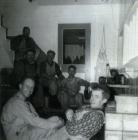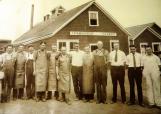1
Relaxing inside the Creamery20th century
The Tatamagouche Creamery, Creamery Road, Tatamagouche, Nova Scotia, Canada
 Credits:
Credits:North Shore Archives
2
The Creamery was an important part of the economy in Tatamagouche as it provided income to not only the local farmers that provided cream, but also to the workers who were employed at the feed mill and in the Creamery itself. The number of employees varied between fourteen in the early days to eighteen or more as production increased. Extra help was needed in the summer months and another four workers were often temporarily employed.Later on, construction of the warehouse in the 1940's and the feed mill in 1958 created more jobs. Regular positions at the Creamery included butter makers, can washers, pasteurizer workers, weighers, testers, printer operators, office workers, boilermen and truck drivers. However, all of the employees could multi-task and in addition to the butter making process, were prepared to repair piping, paint machinery and make butter boxes for shipping butter. Even the owner, J.J. Creighton was known to lend a hand in the numerous tasks required to keep the Creamery running!
One particulary important job at the Creamery was that of the truck drivers who picked up cream from the surrounding farms and delivered it to the Creamery to be used in butter production. There were 13 routes collecting from 1258 dairy farms from Pugwash to River John. Drivers went twice a week, but the Brule and Middleton area were high producers so there were three collections a week. Trucks were housed in the garage, together with the cream cans - it became very crowded at times! One of the truck drivers serving seven routes was said to know 800 farmers by a cream can number!
Here is a chronicle of a few of the former employees of the Tatamagouche Creamery and their memories.
3
Employees outside of the Creamery20th century
The Tatamagouche Creamery, Creamery Road, Tatamagouche, Nova Scotia, Canada
 Credits:
Credits:North Shore Archives
4
Raymond Lewis, former employee of the Creamery20th - 21st century
Coopers Road, Tatamagouche, Novia Scotia, Canada
 Credits:
Credits:Raymond Lewis
5
Raymond Lewis worked at the Creamery from 1969, and recalls packing the prints into 56 lb boxes and carrying them to the cool room. He also remembers all too well the occasion he received a face of steam from the pipes leading to the pasteurizer!He remembered butter being .69 cents a lb in 1969/70 and that he earned $42.00 in two weeks.
Ready to turn his hand to whatever task was needed, Raymond recalls cleaning cans, putting them in storage, and working in the feed mill to unload train cars of grain. He hauled grain sacks, chicken scratch, laying mash and helped mix cattle feed for farmers. He recalls that Boyd Matheson ran the hardware store.
In the garage, Raymond paced out the approximate size of the cooler where , after Scotsburn had taken over, were stored incoming supplies of dairy produce and juice, which in the past he had helped unload.
These supplies were eventually taken to stores, after Windblown Dairy at Waldegrave was bought out by Scotsburn.
6
Ronald Mingo, former employee of the Creamery20th - 21st century
The Tatamagouche Creamery, Creamery Road, Tatamagouche, Nova Scotia, Canada
 Credits:
Credits:Ronald Mingo
7
Ron was a truck driver, doing the Malagash, Westchester, New Annan run two times a week. Some farmers still brought their cream to the Creamery, and he commented on the fact that in the past, trains stopped more or less on request for farmers to load their cream. The wholemilk went to the dairy - Windblown, or Tattrie Brothers, Dairy at Waldegrave, until it was bought out by Scotsburn.He remembered after Scotsburn took over, when the feed mill changed from being Masterfeeds to the Co-op, and grain being brought in by large trucks not by train.
Occasionally it was necessary for him to climb into the back of the cold boiler to check it out, and he often had to sling a heavy can between his legs to get the impetus to swing it on to the truck. Ron experienced trying times in winter collecting cream, when road conditions were far from favourable.The 'boss' insisted that the cream be collected so he went, with disasterous results to the tires and bodywork of Ron's truck. He made it back with the cream, but dreading what J J. would say. In fact J.J. just laughed, and had the truck repaired.
8
Willis Bonnyman, fromer employee of the Creamery20th century
Tatamagouche, Nova Scotia, Canada
 Credits:
Credits:Shirley Brinkhurst
9
Willis, now in his 90's, still lives with his wife, Isabel, in the elegant house his father G.W. Bonnyman, built at the top of Creamery Road. Willis worked at the Creamery from 1937 to 1981, and in that time he was able to perform all the jobs and learned the processes of butter making, becoming the Head Butter Maker for a number of years. He recalls the many changes that took place over the years, and unlike some, thought the Creamery would survive the 'take over' by Scotsburn, as it did for about 27 years before finally closing in 1992. A new plant was being built at Truro, and the cost of updating and renovating the Tatamagouche Creamery, was considered un-economic.In 1958 Willis helped construct the feedmill, using the crane and mechinery of the repair crew working at Lockerby Bridge a short distance away.
Willis also recalled the small tags that were attached to the cream cans showing how much cream arrived in the can.
At one time he said that 8 gallon cans of buttermilk were sent to Alex Ross who owned a milk bar as far away as Sydney, Cape Breton, but who still wanted Tatamagouche buttermilk.
10
James MacPherson, former employee at the Creamery, and his granddaughter20th century
The Tatamagouche Creamery, Creamery Road, Tatamagouche, Nova Scotia, Canada
 Credits:
Credits:Trudy Russell
James Russell
11
James 'Jim' MacPherson, here pictured with his daughter, began working at the Creamery in the 1940's driving one of the cream trucks but soon began to learn the process of butter making. Unlike some of the employees, Jim did not attend the Nova Scotia Agricultural College for courses in making butter, but rather learned through working with the others at the Creamery. This process seemed to have worked because apparently customers who came to the Creamery began asking specifically for butter Jim had made! It is therefore perhaps not surprising that in 1965 he received the Best Butter Maker in Nova Scotia Award.12
Mike Weatherby, former employee at the Creamery20th - 21st century
Main Street, Tatamagouche, Nova Scotia, Canada
 Credits:
Credits:Mike Weatherby
13
Mike Weatherby started work at the Creamery in the late 1970's when he was 18 , and George Semple was the manager. He worked there until the Creamery closed , by which time he was the foreman. Mike remembers working with Willis Bonnyman, Eric Hasket, Ronnie Mingo, Aubrey Kirk, and Boyd Matheson. He also recalled that Jonathan Lepper and Scott Cameron were summer employees.In the summer Mike custom mixed grain in the feedmill and added molasses as required. He helped load trucks and worked the butter churn, taking the butter to the printer using the hydraulic butter bath.
He recalls that in the 1970's that the old printer was still in use as well as hardwood paddles for emptying the butter churn, but by the 80's plastic paddles were in use. In the late 1980's Mike said there were seven pasteurizers, two small ones, four holding 1200 gallons and one large pasteurizer holding 3600 gallons.
Mike worked seven days a week with four weeks holiday, and was paid $3.75 per hour, rising to $12.15 by the time he left. There were also good benefits and a pension plan. In later years Mike worked in the evenings, cleaning equipment in readiness for an early start the next day when he came in to start the boiler. Sometimes his girlfriend, Susan, worked with him - while he cleaned she made up the 30 lb cardboard butter boxes, so there was a good supply for the start of the next day.
One never forgotten memory was the receiving of a jet of scalding steam in the face two days before his wedding. The wedding was not postponed!